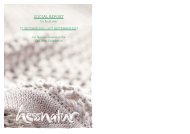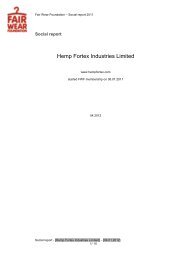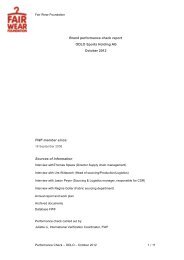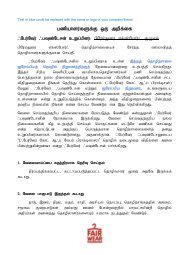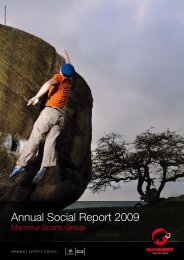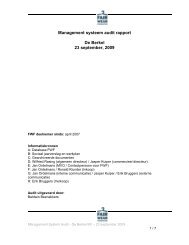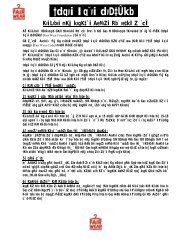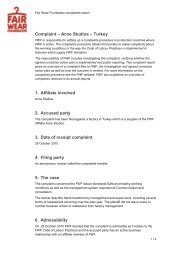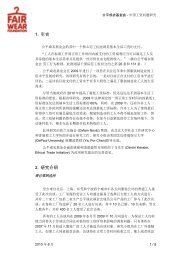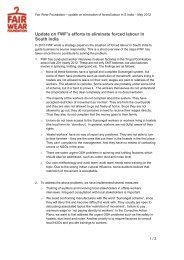Background Study Tirupur - Fair Wear Foundation
Background Study Tirupur - Fair Wear Foundation
Background Study Tirupur - Fair Wear Foundation
Create successful ePaper yourself
Turn your PDF publications into a flip-book with our unique Google optimized e-Paper software.
1. Introduction<br />
Whenever the FWF starts to operate in countries where garments are being produced<br />
for FWF (prospective) member companies, the first step is the make a background<br />
study for "members of the FWF". Often this study will refer to a specific region of the country,<br />
as garments are often produced in particular regional clusters.<br />
This study has four different parts serving four different purposes:<br />
-1 To give an overall context to asses the limits and possibilities of the companies involved<br />
to improve labour standards.<br />
-2 To facilitate the verification process by the FWF and the monitoring task of member<br />
companies by giving an overview of current legislation, and relevant court cases regarding<br />
the labour standards and other types of regulation concerning the labour standards.<br />
-3 Similar to 3 but then focussing on Health & Safety laws and regulations.<br />
-4 The background study contains an inventory of the stakeholder organisations that<br />
could be asked to participate in the partner network.<br />
This study is a working document. (Parts of) the background study can be updated at any<br />
time.<br />
This study refers to the state of Tamil Nadu in India and more specific the town of <strong>Tirupur</strong>.<br />
1.1. Sources<br />
Contributions to this study have been made by:<br />
CARE (Community Awareness Research Education) in Coimbatore<br />
PRIA (Society for Participatory Research in Asia) in New Delhi.<br />
Additional information by the FWF from secondary sources is included. Major sources are:<br />
- IICCI: Comparative analysis of Textile districts in Italy and India. Published by:<br />
The Indo-Italian Chamber of Commerce and Industry, Mumbai - 400 025. India.<br />
- Sujana Krishnamoorthy: Structure of the Garments Industry and Labour Rights in<br />
India, The Post MFA Context. CEC 2003.<br />
- D. Müller-Falcke: Problems in the development of Local Associations: Some Observations<br />
from India. ZEF Bonn .<br />
- Nick Robins and Sarah Roberts (ed): The reality of sustainable trade. IIED (International<br />
Institute for Environment and Development) April 2000<br />
- Meenu Tewari and Jeffery Goebel: Small Firm Competitiveness in a Trade Liberalized<br />
World. Lessons for Tamil Nadu. April 2002<br />
- G. Joshi (ed): Garment industry in South Asia; rags or riches. ILO 2002.<br />
- http://www.saarcnet.com/newsaarcnet/countryprofile/India/india27.html (Excerpt<br />
from: South Asian Association For Regional Cooperation (SAARC); country profile<br />
India)<br />
- Association for Stimulating the Know-how (ASK): Basic information on regional<br />
labour conditions in the region of Mumbai, prestudy report for FWF 2001.<br />
- Labor Market and Social Insurance Policy in India: A Case of Losing on Both<br />
Competitiveness and Caring. Ramgopal Agarwala and Zafar Dad Khan. Worldbank<br />
paper. Stock No. 37168<br />
- Nike and Gap India Country Reports (report written by ACCORD for Global Alliance<br />
on workers’life situation, http://www.theglobalalliance.org/pdf/india-needsassessment-nike-2003.PDF)<br />
3



